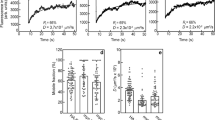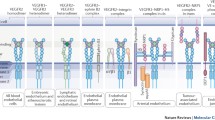Abstract
Purinergic P2 receptors are critical regulators of several functions within the vascular system, including platelet aggregation, vascular inflammation, and vascular tone. However, a role for ATP release and P2Y receptor signalling in angiogenesis remains poorly defined. Here, we demonstrate that blood vessel growth is controlled by P2Y2 receptors. Endothelial sprouting and vascular tube formation were significantly dependent on P2Y2 expression and inhibition of P2Y2 using a selective antagonist blocked microvascular network generation. Mechanistically, overexpression of P2Y2 in endothelial cells induced the expression of the proangiogenic molecules CXCR4, CD34, and angiopoietin-2, while expression of VEGFR-2 was decreased. Interestingly, elevated P2Y2 expression caused constitutive phosphorylation of ERK1/2 and VEGFR-2. However, stimulation of cells with the P2Y2 agonist UTP did not influence sprouting unless P2Y2 was constitutively expressed. Finally, inhibition of VEGFR-2 impaired spontaneous vascular network formation induced by P2Y2 overexpression. Our data suggest that P2Y2 receptors have an essential function in angiogenesis, and that P2Y2 receptors present a therapeutic target to regulate blood vessel growth.






Similar content being viewed by others
Data and materials availability
Further information and requests for materials should be directed to the corresponding author Wolfgang Holnthoner. All raw files from mRNA analyses are available in the gene expression omnibus (GEO) under accession number GSE133795.
References
Burnstock G, Ralevic V (2014) Purinergic signaling and blood vessels in health and disease. Pharmacol Rev 66:102–192. https://doi.org/10.1124/pr.113.008029
Eltzschig HK, Sitkovsky MV, Robson SC (2012) Purinergic signaling during inflammation. N Engl J Med 367:2322–2333. https://doi.org/10.1056/NEJMra1205750
Wang L, Karlsson L, Moses S et al (2002) P2 receptor expression profiles in human vascular smooth muscle and endothelial cells. J Cardiovasc Pharmacol 40:841–853. https://doi.org/10.1097/00005344-200212000-00005
Jin H, Seo J, Eun SY et al (2014) P2Y2 R activation by nucleotides promotes skin wound-healing process. Exp Dermatol 23:480–485. https://doi.org/10.1111/exd.12440
Gidlöf O, Sathanoori R, Magistri M et al (2015) Extracellular uridine triphosphate and adenosine triphosphate attenuate endothelial inflammation through miR-22-mediated ICAM-1 inhibition. J Vasc Res 52:71–80. https://doi.org/10.1159/000431367
Rumjahn SM, Yokdang N, Baldwin KA et al (2009) Purinergic regulation of vascular endothelial growth factor signaling in angiogenesis. Br J Cancer 100:1465–1470. https://doi.org/10.1038/sj.bjc.6604998
Jacobson KA, Ivanov AA, de Castro S et al (2009) Development of selective agonists and antagonists of P2Y receptors. Purinergic Signal 5:75–89. https://doi.org/10.1007/s11302-008-9106-2
Seye CI, Yu N, González FA et al (2004) The P2Y2 nucleotide receptor mediates vascular cell adhesion molecule-1 expression through interaction with VEGF receptor-2 (KDR/Flk-1). J Biol Chem 279:35679–35686. https://doi.org/10.1074/jbc.M401799200
Liao Z, Cao C, Wang J et al (2014) The P2Y2 receptor interacts with VE-cadherin and VEGF receptor-2 to regulate Rac1 activity in endothelial cells. J Biomed Sci Eng 7:1105–1121. https://doi.org/10.4236/jbise.2014.714109
McEnaney RM, Shukla A, Madigan MC et al (2016) P2Y2 nucleotide receptor mediates arteriogenesis in a murine model of hind limb ischemia. J Vasc Surg 63:216–225. https://doi.org/10.1016/j.jvs.2014.06.112
Sivaraj KK, Li R, Albarran-Juarez J et al (2015) Endothelial Gαq/11 is required for VEGF-induced vascular permeability and angiogenesis. Cardiovasc Res 108:171–180. https://doi.org/10.1093/cvr/cvv216
Liu J, Liao Z, Camden J et al (2004) Src homology 3 binding sites in the P2Y2 nucleotide receptor interact with Src and regulate activities of Src, proline-rich tyrosine kinase 2, and growth factor receptors. J Biol Chem 279:8212–8218. https://doi.org/10.1074/jbc.M312230200
Erb L, Weisman GA (2015) Coupling of P2Y receptors to G proteins and other signaling pathways. Wiley Interdiscip Rev Membr Transp Signal 1:789–803. https://doi.org/10.1002/wmts.62
Wang S, Iring A, Strilic B et al (2015) P2Y2 and Gq/G11 control blood pressure by mediating endothelial mechanotransduction. J Clin Invest 125:3077–3086. https://doi.org/10.1172/JCI81067
Petzelbauer P, Bender JR, Wilson J, Pober JS (1993) Heterogeneity of dermal microvascular endothelial cell antigen expression and cytokine responsiveness in situ and in cell culture. J Immunol 151:5062–5072
Priglinger E, Maier J, Chaudary S et al (2018) Photobiomodulation of freshly isolated human adipose tissue-derived stromal vascular fraction cells by pulsed light-emitting diodes for direct clinical application. J Tissue Eng Regen Med 12:1352–1362. https://doi.org/10.1002/term.2665
Sathanoori R, Bryl-Gorecka P, Müller CE et al (2017) P2Y2 receptor modulates shear stress-induced cell alignment and actin stress fibers in human umbilical vein endothelial cells. Cell Mol Life Sci 74:731–746. https://doi.org/10.1007/s00018-016-2365-0
Weihs AM, Fuchs C, Teuschl AH et al (2014) Shock wave treatment enhances cell proliferation and improves wound healing by ATP release-coupled extracellular signal-regulated kinase (ERK) activation. J Biol Chem 289:27090–27104. https://doi.org/10.1074/jbc.M114.580936
Hoffmann C, Ziegler Reiner et al (2008) Agonist-selective, receptor-specific interaction of human P2Y receptors with beta-arrestin-1 and -2. J Biol Chem 283:30933–30941. https://doi.org/10.1074/jbc.M801472200
Knezevic L, Schaupper M, Mühleder S et al (2017) Engineering blood and lymphatic microvascular networks in fibrin matrices. Front Bioeng Biotechnol 5:1–12. https://doi.org/10.3389/fbioe.2017.00025
Hackethal J, Mühleder S, Hofer A et al (2017) An effective method of Atelocollagen type 1/3 isolation from human placenta and its in vitro characterization in two-dimensional and three-dimensional cell culture applications. Tissue Eng Part C Methods 23:274–285. https://doi.org/10.1089/ten.tec.2017.0016
Rohringer S, Holnthoner W, Hackl M et al (2014) Molecular and cellular effects of in vitro shockwave treatment on lymphatic endothelial cells. PLoS One 9:e114806. https://doi.org/10.1371/journal.pone.0114806
Sharov AA, Schlessinger D, Ko MSH (2015) ExAtlas: an interactive online tool for meta-analysis of gene expression data. J Bioinform Comput Biol 13:1550019. https://doi.org/10.1142/S0219720015500195
Qiagen IPA. https://www.qiagenbioinformatics.com/products/ingenuity-pathway-analysis. Accessed 4 July 2019
Liberzon A, Birger C, Thorvaldsdóttir H et al (2015) The molecular signatures database hallmark gene set collection. Cell Syst 1:417–425. https://doi.org/10.1016/j.cels.2015.12.004
Morpheus. https://software.broadinstitute.org/morpheus. Accessed 4 July 2019
Holnthoner W, Hohenegger K, Husa A-M et al (2015) Adipose-derived stem cells induce vascular tube formation of outgrowth endothelial cells in a fibrin matrix. J Tissue Eng Regen Med 9:127–136. https://doi.org/10.1002/term.1620
Hasenberg T, Mühleder S, Dotzler A et al (2015) Emulating human microcapillaries in a multi-organ-chip platform. J Biotechnol 216:1–10. https://doi.org/10.1016/j.jbiotec.2015.09.038
Wang L, Östberg O, Wihlborg AK et al (2003) Quantification of ADP and ATP receptor expression in human platelets. J Thromb Haemost 1:330–336. https://doi.org/10.1046/j.1538-7836.2003.00070.x
Sharma S, Rao A (2009) RNAi screening: tips and techniques. Nat Immunol 10:799–804. https://doi.org/10.1038/ni0809-799.RNAi
Du D, Zhou Z, Zhu L et al (2018) TNF-α suppresses osteogenic differentiation of MSCs by accelerating P2Y2 receptor in estrogen-deficiency induced osteoporosis. Bone. https://doi.org/10.1016/j.bone.2018.09.012
Shinozaki Y, Shibata K, Yoshida K et al (2017) Transformation of astrocytes to a neuroprotective phenotype by microglia via P2Y1 Receptor downregulation. Cell Rep 19:1151–1164. https://doi.org/10.1016/j.celrep.2017.04.047
Kobayashi K, Yamanaka H, Fukuoka T et al (2008) P2Y12 receptor upregulation in activated microglia is a gateway of p38 signaling and neuropathic pain. J Neurosci 28:2892–2902. https://doi.org/10.1523/JNEUROSCI.5589-07.2008
Godecke S, Roderigo C, Rose CR et al (2012) Thrombin-induced ATP release from human umbilical vein endothelial cells. AJP Cell Physiol 302:C915–C923. https://doi.org/10.1152/ajpcell.00283.2010
Tian S, Quan H, Xie C et al (2011) YN968D1 is a novel and selective inhibitor of vascular endothelial growth factor receptor-2 tyrosine kinase with potent activity in vitro and in vivo. Cancer Sci 102:1374–1380. https://doi.org/10.1111/j.1349-7006.2011.01939.x
Savant S, La Porta S, Budnik A et al (2015) The orphan receptor Tie1 controls angiogenesis and vascular remodeling by differentially regulating Tie2 in Tip and stalk cells. Cell Rep 12:1761–1773. https://doi.org/10.1016/j.celrep.2015.08.024
La Porta S, Roth L, Singhal M et al (2018) Endothelial Tie1-mediated angiogenesis and vascular abnormalization promote tumor progression and metastasis. J Clin Invest 128:834–845. https://doi.org/10.1172/JCI94674
Rafehi M, Burbiel JC, Attah IY et al (2017) Synthesis, characterization, and in vitro evaluation of the selective P2Y2 receptor antagonist AR-C118925. Purinergic Signal 13:89–103. https://doi.org/10.1007/s11302-016-9542-3
Zhou Z, Chrifi I, Xu Y et al (2016) Uridine adenosine tetraphosphate acts as a proangiogenic factor in vitro through purinergic P2Y receptors. Am J Physiol Circ Physiol 311:H299–H309. https://doi.org/10.1152/ajpheart.00578.2015
Erb L, Weisman GA (2012) Coupling of P2Y receptors to G proteins and other signaling pathways. Wiley Interdiscip Rev Membr Transp Signal 1:789–803. https://doi.org/10.1002/wmts.62
Andreev J, Galisteo ML, Kranenburg O et al (2001) Src and Pyk2 mediate G-protein-coupled receptor activation of epidermal growth factor receptor (EGFR) but are not required for coupling to the mitogen-activated protein (MAP) kinase signaling cascade. J Biol Chem 276:20130–20135. https://doi.org/10.1074/jbc.M102307200
Strasser GA, Kaminker JS, Tessier-lavigne M, Dc W (2012) Microarray analysis of retinal endothelial tip cells identifies CXCR1 as a mediator of tip cell morphology and branching. Blood 115:5102–5110. https://doi.org/10.1182/blood-2009-07-230284
Toro R, Prahst C, Mathivet T et al (2010) Identification and functional analysis of endothelial tip cell enriched genes. Blood 116:4025–4033. https://doi.org/10.1182/blood-2010-02-270819
Siemerink MJ, Klaassen I, Vogels IMC et al (2012) CD34 marks angiogenic tip cells in human vascular endothelial cell cultures. Angiogenesis 15:151–163. https://doi.org/10.1007/s10456-011-9251-z
Felcht M, Luck R, Schering A et al (2012) Angiopoietin-2 differentially regulates angiogenesis through TIE2 and integrin signaling. J Clin Invest 122:1991–2005. https://doi.org/10.1172/JCI58832
Potente M, Gerhardt H, Carmeliet P (2011) Basic and therapeutic aspects of angiogenesis. Cell 146:873–887. https://doi.org/10.1016/j.cell.2011.08.039
Benedito R, Rocha SF, Woeste M et al (2012) Notch-dependent VEGFR3 upregulation allows angiogenesis without VEGF-VEGFR2 signalling. Nature 484:110–114. https://doi.org/10.1038/nature10908
Lampugnani MG, Orsenigo F, Gagliani MC et al (2006) Vascular endothelial cadherin controls VEGFR-2 internalization and signaling from intracellular compartments. J Cell Biol 174:593–604. https://doi.org/10.1083/jcb.200602080
Khalafalla FG, Greene S, Khan H et al (2017) P2Y2 nucleotide receptor prompts human cardiac progenitor cell activation by modulating hippo signaling. Circ Res 121:1224–1236
Rocha SF, Schiller M, Jing D et al (2014) Esm1 modulates endothelial tip cell behavior and vascular permeability by enhancing VEGF bioavailability. Circ Res 115:581–590. https://doi.org/10.1161/CIRCRESAHA.115.304718
Potente M, Mäkinen T (2017) Vascular heterogeneity and specialization in development and disease. Nat Rev Mol Cell Biol 18:477–494. https://doi.org/10.1038/nrm.2017.36
Jakobsson L, Franco CA, Bentley K et al (2010) Endothelial cells dynamically compete for the tip cell position during angiogenic sprouting. Nat Cell Biol 12:943–953. https://doi.org/10.1038/ncb2103
Acknowledgements
The authors thank Johannes Zipperle for isolating human platelets and Regina Grillari for providing Phoenix Ampho cells. This work was funded in part by the European Union’s INTERREG V-A AT-CZ programme (ATCZ133), the City of Vienna Competence Team SignalTissue (#18-08) and by the Austrian Science Fund project SFB-F54. The funding sources have no influence on design and conduct of the study, collection, management, analysis and interpretation of the data, and preparation, review, or approval of the manuscript.
Author information
Authors and Affiliations
Contributions
SM performed retroviral infections, spheroid and fibrin matrix assays, flow cytometry, RT-PCR, and immunoprecipitations. SM and KL generated retroviral plasmids. CF and DS performed immunoblotting. SM and KP performed proliferation assays and analyzed iPSC-ECFC in flow cytometry. JP generated the gene array data. CS and JB analyzed gene array data. EP and CH supported the study by providing material. PS, WJ, and HR co-advised the project. SM and WH designed the figures and wrote the manuscript. WH was the lead advisor of this work. All authors read and approved the manuscript.
Corresponding author
Ethics declarations
Conflict of interest
The authors declare no competing interests.
Additional information
Publisher's Note
Springer Nature remains neutral with regard to jurisdictional claims in published maps and institutional affiliations.
Electronic supplementary material
Below is the link to the electronic supplementary material.
18_2019_3213_MOESM2_ESM.avi
Supplementary material 2 (AVI 3292 kb) Supplementary movie 1: Z-scan image sequence of P2Y2OE-HUVEC embedded in a fibrin matrix assay in co-culture with MSC. The P2Y2-YFP fusion protein is localized in the cytoplasm, on cell–cell borders and on filopodia
Rights and permissions
About this article
Cite this article
Mühleder, S., Fuchs, C., Basílio, J. et al. Purinergic P2Y2 receptors modulate endothelial sprouting. Cell. Mol. Life Sci. 77, 885–901 (2020). https://doi.org/10.1007/s00018-019-03213-2
Received:
Revised:
Accepted:
Published:
Issue Date:
DOI: https://doi.org/10.1007/s00018-019-03213-2




